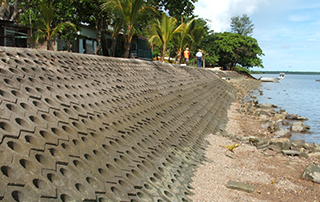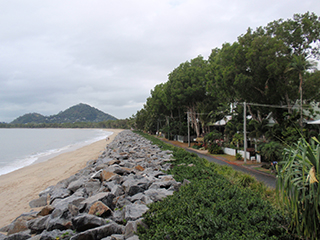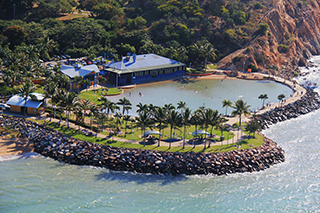 Seawalls are commonly used to provide a physical barrier to continuing shoreline recession. Properly designed and constructed seawalls can be very effective in protecting foreshore assets by stopping any further shoreline recession.
Seawalls are commonly used to provide a physical barrier to continuing shoreline recession. Properly designed and constructed seawalls can be very effective in protecting foreshore assets by stopping any further shoreline recession.
However seawalls significantly interfere with natural beach processes by separating the active beach from sand reserves stored in beach ridges and dunes. In other words, seawalls can protect property behind the wall, but they do not prevent in any way the erosion processes continuing on the beach in front of them. In fact they may exacerbate and accelerate erosion.
Typically the effect of seawall construction on actively eroding shores is for the level of the beach in front of it to steadily lower – until the beach reaches a new equilibrium profile.
This lowering is primarily caused by wave action washing against the wall causing a high degree of turbulence in front of the structure – which scours the beach material. Wave energy reflected from the seawall also contributes to these scour and beach lowering processes. In many cases this lowering continues until the level of the beach is below prevailing tide levels, in which case the ocean simply washes against the face of the seawall and there is no beach for part (or possibly for all) of the tide cycle. The amenity of the beach and foreshore is therefore significantly degraded in order for the seawall to protect the area behind it.
 This lowering of the sand level in front of seawalls can also present problems for the overall stability of the structure. Unless appropriate foundation and toe arrangements are constructed, the seawall can fail by undermining. Even if only damaged, it is extremely difficult and very expensive to repair existing seawalls that have been damaged by undermining. Indeed frequently the most cost effective solution is to demolish the structure and rebuild it with deeper and more robust foundations.
This lowering of the sand level in front of seawalls can also present problems for the overall stability of the structure. Unless appropriate foundation and toe arrangements are constructed, the seawall can fail by undermining. Even if only damaged, it is extremely difficult and very expensive to repair existing seawalls that have been damaged by undermining. Indeed frequently the most cost effective solution is to demolish the structure and rebuild it with deeper and more robust foundations.
Another typically adverse impact of seawalls is that the original erosion problem that they were meant to solve is simply relocated further along the shore. Natural beach processes can no longer access the sand reserves in the upper part of the active beach that are behind the seawall. Consequently this sand cannot be moved downdrift by natural longshore sand transport processes to replenish the sand that these same processes are moving along the shoreline beyond the end of the seawall.
The deficit in sand supply to these downdrift sections initiates greater erosion, ultimately requiring extension of the seawall along the entire downdrift shoreline in order to protect it.
Seawalls have an effect on the visual amenity of a shoreline, and this can be adverse if the wall is high – or if it becomes so as a consequence of natural beach lowering in front of it. Such walls also inhibit easy public access across the foreshore onto the beach. Typically access stairways or ramps need to be provided on seawalls to ensure the safety of beach access by pedestrians.
Along urban foreshores, seawalls can offer sheltered habitats for vermin such as feral cats and rodents. This can adversely affect natural coastal flora and fauna values.
Appropriately designed and constructed seawalls can be expensive and do not always compare favourably with the cost of other alternatives. However many seawalls constructed in Australia have been built of rock during or immediately following severe sea conditions and significant storm/cyclone erosion events. Under such circumstances appropriate design and construction of these walls may not have been implemented. Consequently most of the rock walls constructed in this manner require significant maintenance to prevent structural failure and the re-establishment of the original erosion problem.
 Despite their disadvantages, rock seawalls are probably the most commonly used method in Australia for protecting foreshore assets against the threat of erosion. This can probably be attributed to their versatility. They are relatively easy to construct using conventional earthmoving plant and equipment; and this is often accomplished by simply dumping rock on a prepared slope rather than applying more appropriate construction practises to create a robust structure.
Despite their disadvantages, rock seawalls are probably the most commonly used method in Australia for protecting foreshore assets against the threat of erosion. This can probably be attributed to their versatility. They are relatively easy to construct using conventional earthmoving plant and equipment; and this is often accomplished by simply dumping rock on a prepared slope rather than applying more appropriate construction practises to create a robust structure.
Such adhoc methods can be used to not only protect long sections of foreshore, but also individual private properties. The substantial and solid appearance of rock walls can provide owners of foreshore assets with a sense of security – which unfortunately is frequently misguided given the often inadequate design and construction of these structures. Their subsequent failure or damage can not only lead to the re-establishment of the original erosion problem, but the scattering of removed rocks can adversely affect foreshore use and visual amenity.
So…. blight? …….or remedy? You may need a coastal engineer to assist you in that evaluation.










